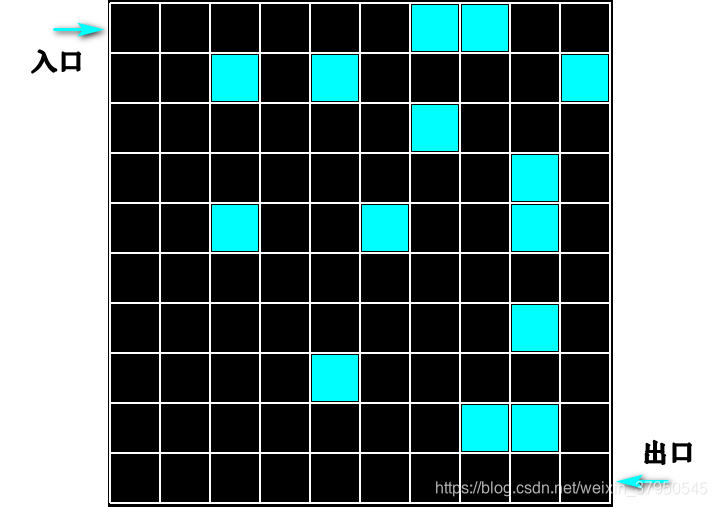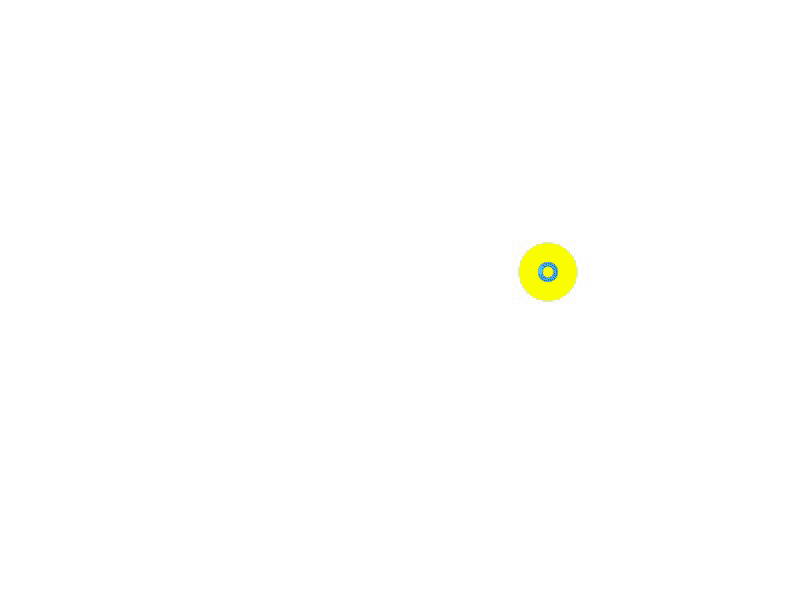《数据结构、算法与应用 —— C++语言描述》学习笔记 — 栈 —— 应用 —— 迷宫老鼠
一、问题描述
迷宫是一个矩形区域,有一个入口和一个出口。迷宫内部包含不能穿越的墙壁或障碍物。这些障碍物沿着行和列防止,与迷宫的边界平行。迷宫的如果在左上角,出口在右下角。

我们可以使用一个 bool 矩阵来描述这个迷宫。当矩阵中某个位置有障碍时,其值为 ture,否则为 false。迷宫老鼠问题是要寻找一条从入口到出口的路径。路径是一个由位置组成的序列。每一个位置都没有障碍,而且除入口之外,路径上的每个位置是前一个位置在东、南、西、北上相邻的一个位置。
二、设计
我们采用自顶向下的方法设计这个程序。不难理解,这个程序有三个部分:输入迷宫,寻找路径和输出路径。书中使用三个模块实现这些部分。我们这里把输入和输出模块作为放在一起,除此之外,我们还有一个模块用于显示欢迎信息、软件名称及作者信息。为了简便,我们这里使用QT6.1.2 开发。
1、思路
该程序主体流程是:进入欢迎界面;让用户设置迷宫形状;根据用户的需要绘制迷宫;在用户点击寻找路径的按钮时绘制路径(支持多次绘制,暂不支持擦除)。
首先思考主体界面。主体界面自身有一个类。其实例中应该还有含有两个子对象。分别用于存放欢迎界面和迷宫界面(可以将设置界面独立)。由于这两个子对象不会同时显示,我们可以考虑使用 QStackedWidget 存放。
然后考虑欢迎界面。我们需要确认采取显示欢迎字样。这里我选择一个较为简单的淡入淡出的 label。由于该类可以由其它类复用,因此我们将公共接口提取并放在 util 文件夹中。
最后考虑迷宫界面。主体的布局采取左边为交互界面,右边为显式界面。比例为1:3。考虑到计算迷宫的策略可以动态切换,因此我们将计算迷宫的方式单独出来放在 business 文件夹中。二者之间的数据传递是一个 QVector<QVector> 用于表示地图每个矩形的状态。
2、类图

3、目录结构
[RatInMaze]
RatInMaze.pro
[document]
[output]
[src]
main.cpp
[business]
CLS_FindPathStack.h
CLS_FindPathStack.cpp
[ui]
CLS_MainWidget.h
CLS_MainWidget.cpp
CLS_MainWidget.ui
CLS_Maze.h
CLS_Maze.cpp
CLS_Maze.ui
CLS_Welcome.h
CLS_Welcome.cpp
CLS_Welcome.ui
[util]
CLS_LabelGradualChange.h
CLS_LabelGradualChange.cpp
三、实现
1、ui文件
CLS_MainWidget.ui

CLS_Welcome.ui

CLS_Maze.ui

2、淡入淡出 label
qt 中的 css 不支持设置动画,因此需要使用定时器或线程实现淡入淡出。我们这里选择使用线程计时。淡入淡出的基本原理就是不断地改变透明度。
类声明为:
#ifndef CLS_LABELGRADUALCHANGE_H
#define CLS_LABELGRADUALCHANGE_H
#include <QLabel>
class CLS_LabelGradualChange : public QLabel
{
Q_OBJECT
public:
explicit CLS_LabelGradualChange(QWidget *parent = nullptr);
~CLS_LabelGradualChange();
/*
* @brief 设置渐变颜色
* @param color 目标颜色
*/
void setColor(QColor color);
/*
* @brief 设置淡入淡出时长
* @param timeout 总时长
*/
void setTimeout(int timeout);
/*
* @brief 设置颜色变化的总次数
* @param timeout 总时长
*/
void setTotalTimes(int totalTimes);
signals:
void sigLoadFinished();
protected:
virtual void showEvent(QShowEvent *event) override;
private:
QString m_qstrStyleSheet; // 预设的样式表,需要使用.arg拼接透明度
int m_iTimeout = 0; // 淡入淡出时长
int m_iTotalTimes = 0; // 颜色变化的总次数
int m_iTimes = 0;
bool m_blShow = true;
void startShowThread(); // 线程中计时
private slots:
/*
* @brief 更新透明度槽
*/
void slotShow();
};
#endif // CLS_LABELGRADUALCHANGE_H
实现文件:
#include "CLS_LabelGradualChange.h"
#include <QColor>
#include <QThread>
const int CONST_SHOW_TIMES = 20; // 默认显示20次
CLS_LabelGradualChange::CLS_LabelGradualChange(QWidget *parent) :
QLabel(parent)
{
m_iTotalTimes = CONST_SHOW_TIMES;
}
CLS_LabelGradualChange::~CLS_LabelGradualChange()
{
}
void CLS_LabelGradualChange::setColor(QColor color)
{
m_qstrStyleSheet = styleSheet() + QString("color:rgba(%2,%3,%4,%5);").arg(color.red())
.arg(color.green()).arg(color.blue());
}
void CLS_LabelGradualChange::setTimeout(int timeout)
{
m_iTimeout = timeout;
}
void CLS_LabelGradualChange::setTotalTimes(int totalTimes)
{
if (totalTimes > 0)
{
m_iTotalTimes = totalTimes;
}
}
void CLS_LabelGradualChange::showEvent(QShowEvent*)
{
if (m_blShow)
{
startShowThread();
m_blShow = false;
}
}
void CLS_LabelGradualChange::startShowThread()
{
double dbInterval = double(m_iTimeout) / m_iTotalTimes;
QThread *pThread = QThread::create([dbInterval](){QThread::msleep(dbInterval);});
connect(pThread, SIGNAL(finished()), this, SLOT(slotShow()));
pThread->start();
}
void CLS_LabelGradualChange::slotShow()
{
++m_iTimes;
double opacity = 2.0 * double(m_iTimes >= m_iTotalTimes / 2 ? m_iTotalTimes - m_iTimes : m_iTimes) / m_iTotalTimes;
setStyleSheet(m_qstrStyleSheet.arg(opacity));
if (m_iTimes < m_iTotalTimes)
{
startShowThread();
}
else
{
emit sigLoadFinished();
}
}
3、欢迎界面
类声明:
#ifndef CLS_WELCOME_H
#define CLS_WELCOME_H
#include <QWidget>
namespace Ui {
class CLS_Welcome;
}
class CLS_Welcome : public QWidget
{
Q_OBJECT
public:
explicit CLS_Welcome(QWidget *parent = nullptr);
~CLS_Welcome();
signals:
/*
* @brief 显式结束信号
*/
void sigLoadFinished();
private:
Ui::CLS_Welcome *ui;
};
#endif // CLS_WELCOME_H
实现文件:
#include "CLS_Welcome.h"
#include "ui_CLS_Welcome.h"
const QString CONST_GAMENAME = QObject::tr("RAT IN A MAZE");
const QString CONST_COPYRIGHT = QObject::tr("@coding-hwz,2021");
const QColor CONST_COLOR_GAMENAME = QColor(150, 152, 18);
const QColor CONST_COLOR_COPYRIGHT = QColor(255, 255, 255);
const int CONST_TIMEOUT = 1500;
CLS_Welcome::CLS_Welcome(QWidget *parent) :
QWidget(parent),
ui(new Ui::CLS_Welcome)
{
ui->setupUi(this);
if (parent)
{
setWindowFlags(Qt::FramelessWindowHint);
}
setStyleSheet("font:30px bold \"Times New Roman\";");
ui->verticalLayout->setSpacing(50);
ui->label_GameName->setText(CONST_GAMENAME);
ui->label_CopyRight->setText(CONST_COPYRIGHT);
ui->label_GameName->setAlignment(Qt::AlignCenter);
ui->label_CopyRight->setAlignment(Qt::AlignCenter);
ui->label_GameName->setColor(CONST_COLOR_GAMENAME);
ui->label_CopyRight->setColor(CONST_COLOR_COPYRIGHT);
ui->label_GameName->setTimeout(CONST_TIMEOUT);
ui->label_CopyRight->setTimeout(CONST_TIMEOUT);
connect(ui->label_CopyRight, SIGNAL(sigLoadFinished()), this, SIGNAL(sigLoadFinished()));
}
CLS_Welcome::~CLS_Welcome()
{
delete ui;
}
4、迷宫界面
类声明:
#ifndef CLS_MAZE_H
#define CLS_MAZE_H
#include <QWidget>
#include <QStack>
#include "CLS_FindPathStack.h"
namespace Ui {
class CLS_Maze;
}
class CLS_Maze : public QWidget
{
Q_OBJECT
public:
explicit CLS_Maze(QWidget *parent = nullptr);
~CLS_Maze();
protected:
void paintEvent(QPaintEvent*);
void resizeEvent(QResizeEvent*);
void mouseReleaseEvent(QMouseEvent* event);
private slots:
void on_pushButton_FindPath_clicked();
void on_pushButton_Restart_clicked();
private:
Ui::CLS_Maze *ui;
QVector<QVector<QRect>> m_vecRects; // 需要绘制的矩形坐标,先行后列
QVector<QVector<bool>> m_vecRectsStatus; // 矩形状态,为true说明有障碍物,为false没有
QStack<CLS_FindPathStack::mapIndex> m_stackPath; // 从入口到出口的路径
/*
* @brief 初始化矩形坐标
*/
void initRects();
/*
* @brief 绘制矩形
* @param painter 绘图对象
*/
void drawMaze(QPainter& painter);
/*
* @brief 绘制路径
* @param painter 绘图对象
*/
void drawPath(QPainter& painter);
};
#endif // CLS_MAZE_H
实现文件:
#include "CLS_Maze.h"
#include "ui_CLS_Maze.h"
#include <QPainter>
#include <QMouseEvent>
#include <QStack>
#include <optional>
#include <QMessageBox>
const int CONST_LINE_NUM = 10; // 默认每行、列矩形数
const int CONST_MARGIN = 50; // 边距
const int CONST_LINE_WIDTH = 2; // 矩形边线宽
const int CONST_RATIO = 3; // 矩形显示界面与用户控制界面宽度比
const QString CONST_BUTTONTEXT_FINDPATH = QObject::tr("显示路线");
const QString CONST_BUTTONTEXT_RESTART = QObject::tr("重新绘制");
const QString CONST_INFORMATION_NOPATH = QObject::tr("路线不存在");
const QString CONST_BUTTON_STYLE = QString("QPushButton{ \
background-color:rgb(134,183,200);\
border:2px solid #5F92B2;\
border-radius:5px;\
color:white;\
margin: %1 0 %1 %1;\
height: 50px;\
}\
QPushButton:hover{\
background-color:rgb(0,130,150);\
border:2px solid #5F92B2;\
border-radius:5px;\
color:white;\
}\
QPushButton:pressed{\
background-color:rgb(85,170,255);\
border:2px solid #3C80B1;\
border-radius:5px;\
color:white;\
}").arg(CONST_MARGIN);
CLS_Maze::CLS_Maze(QWidget *parent) :
QWidget(parent),
ui(new Ui::CLS_Maze),
m_vecRects(CONST_LINE_NUM, QVector<QRect>(CONST_LINE_NUM)),
m_vecRectsStatus(CONST_LINE_NUM, QVector<bool>(CONST_LINE_NUM))
{
ui->setupUi(this);
ui->horizontalLayout->setStretch(0,1);
ui->horizontalLayout->setStretch(1,CONST_RATIO);
ui->widget_Rect->setStyleSheet("background-color:transparent");
setStyleSheet(CONST_BUTTON_STYLE);
ui->pushButton_FindPath->setText(CONST_BUTTONTEXT_FINDPATH);
ui->pushButton_Restart->setText(CONST_BUTTONTEXT_RESTART);
}
CLS_Maze::~CLS_Maze()
{
delete ui;
}
void CLS_Maze::paintEvent(QPaintEvent*)
{
QPainter painter(this);
painter.setPen(QPen(Qt::white, CONST_LINE_WIDTH));
drawMaze(painter);
drawPath(painter);
}
void CLS_Maze::resizeEvent(QResizeEvent*)
{
initRects();
update(ui->widget_Rect->geometry());
}
void CLS_Maze::mouseReleaseEvent(QMouseEvent* event)
{
auto pos = event->pos();
// 寻找目标点位于矩阵的哪一行
auto find1D = [&pos](QVector<QRect>& vecRect)
{
return vecRect.first().top() < pos.y() && vecRect.last().bottom() > pos.y() &&
vecRect.first().left() < pos.x() && vecRect.last().right() > pos.x();
};
auto iterVec = std::find_if(m_vecRects.begin(), m_vecRects.end(), find1D);
if (iterVec == m_vecRects.end())
{
return;
}
// 寻找目标点位于改行的哪一列
auto find2D = [&pos](QRect& rect)
{
return rect.top() < pos.y() && rect.bottom() > pos.y() && rect.left() < pos.x() && rect.right() > pos.x();
};
auto iterRect = std::find_if(iterVec->begin(), iterVec->end(), find2D);
if (iterRect == iterVec->end())
{
return;
}
m_vecRectsStatus[std::distance(m_vecRects.begin(), iterVec)][std::distance(iterVec->begin(), iterRect)] = true;
update(*iterRect);
}
void CLS_Maze::initRects()
{
m_vecRects.clear();
int iVerticalStart = ui->widget_Rect->geometry().top() + CONST_MARGIN;
int iVerticalDist = (ui->widget_Rect->geometry().height() - 2 * CONST_MARGIN) / CONST_LINE_NUM;
int iHorizontalStart = ui->widget_Rect->geometry().left() + CONST_MARGIN;
int iHorizontalDist = (ui->widget_Rect->geometry().width() - 2 * CONST_MARGIN) / CONST_LINE_NUM;
for (int i = 0; i < CONST_LINE_NUM; ++i)
{
QVector<QRect> vecRect(CONST_LINE_NUM);
for (int j = 0; j < CONST_LINE_NUM; ++j)
{
vecRect[j] = QRect(iHorizontalStart + j * iHorizontalDist, iVerticalStart + i * iVerticalDist,
iHorizontalDist, iVerticalDist);
}
m_vecRects.push_back(std::move(vecRect));
}
}
void CLS_Maze::initRectStatus()
{
for (int i = 0; i < CONST_LINE_NUM; ++i)
{
for (int j = 0; j < CONST_LINE_NUM; ++j)
{
m_vecRectsStatus[i][j] = false;
}
}
}
void CLS_Maze::drawMaze(QPainter& painter)
{
for (int i = 0; i < m_vecRects.size(); ++i)
{
for (int j = 0; j < m_vecRects[i].size(); ++j)
{
painter.drawRect(m_vecRects[i][j]);
if (m_vecRectsStatus[i][j])
{
painter.fillRect(m_vecRects[i][j] - QMargins(CONST_LINE_WIDTH, CONST_LINE_WIDTH, CONST_LINE_WIDTH, CONST_LINE_WIDTH), QColor(0, 255, 255));
}
}
}
}
void CLS_Maze::drawPath(QPainter &painter)
{
QVector<QPoint> path;
for (int i = 0; i < m_stackPath.size() - 1; ++i)
{
auto cur = m_stackPath.at(i);
auto next = m_stackPath.at(i + 1);
path.push_back(m_vecRects.at(cur.first).at(cur.second).center());
path.push_back(m_vecRects.at(next.first).at(next.second).center());
}
painter.drawLines(path);
}
void CLS_Maze::on_pushButton_FindPath_clicked()
{
m_stackPath.clear();
CLS_FindPathStack findPathObj(m_vecRectsStatus);
auto optPath = findPathObj.findPath();
if (optPath.has_value())
{
m_stackPath = optPath.value();
update(ui->widget_Rect->geometry());
}
else
{
QMessageBox::information(nullptr, "", CONST_INFORMATION_NOPATH);
}
}
void CLS_Maze::on_pushButton_Restart_clicked()
{
initRects();
initRectStatus();
m_stackPath.clear();
update(ui->widget_Rect->geometry());
}
这里按钮的样式上网找了个,感觉还可以 —— Qt 精美的button合集。
5、主窗体
类声明:
#ifndef CLS_MAINWIDGET_H
#define CLS_MAINWIDGET_H
#include <QWidget>
QT_BEGIN_NAMESPACE
namespace Ui { class CLS_MainWidget; }
QT_END_NAMESPACE
class CLS_MainWidget : public QWidget
{
Q_OBJECT
public:
CLS_MainWidget(QWidget *parent = nullptr);
~CLS_MainWidget();
/*
* @brief 进入欢迎界面
*/
void welcome();
private:
Ui::CLS_MainWidget *ui;
private slots:
/*
* @brief 加载完成处理槽
*/
void slotLoadFinished();
};
#endif // CLS_MAINWIDGET_H
实现文件:
#include "CLS_MainWidget.h"
#include "ui_CLS_MainWidget.h"
#include "CLS_Welcome.h"
#include "CLS_Maze.h"
CLS_MainWidget::CLS_MainWidget(QWidget *parent)
: QWidget(parent)
, ui(new Ui::CLS_MainWidget)
{
ui->setupUi(this);
setStyleSheet("background-color:#000;");
}
CLS_MainWidget::~CLS_MainWidget()
{
delete ui;
}
void CLS_MainWidget::welcome()
{
auto pMaze = new CLS_Maze;
ui->stackedWidget->addWidget(pMaze);
auto pWelcome = new CLS_Welcome;
int index = ui->stackedWidget->addWidget(pWelcome);
connect(pWelcome, SIGNAL(sigLoadFinished()), this, SLOT(slotLoadFinished()));
ui->stackedWidget->setCurrentIndex(index);
}
void CLS_MainWidget::slotLoadFinished()
{
ui->stackedWidget->removeWidget(ui->stackedWidget->currentWidget());
}
6、算法
从迷宫的内部位置开始,每个点都有四个移动方向,上下左右。从迷宫的边界开始,则只有两种或三种移动方向。为了避免再处理内部位置和边界位置是存在差异,我们可以在迷宫的周围增加一圈障碍物。因此迷宫的行列都将各增加2.这样虽然会稍稍增加所需要的空间。但是却让我们简化了代码的设计。
我们这里考虑使用栈结构来保存结果路径。初始情况下,仅有矩阵坐标(1,1)放入栈中。然后我们需要决定下一次向哪里移动。为了简便处理四个方向的移动,我们用一个数组保存四个方向行、列的移动距离:(0,1)、(1,0)、(-1,0)、(0,-1),右下左上。这同样也是我们寻找路径考虑方向的优先级顺序。为了不重复已经走过的路程,我们每走过一个矩阵就将其标记为 true。
注意我们这个算法并不能保证能找到最短路径。
类声明:
#ifndef CLS_FINDPATHSTACK_H
#define CLS_FINDPATHSTACK_H
#include <QGenericMatrix>
class CLS_FindPathStack
{
public:
typedef QPair<int, int> mapIndex; // 矩阵坐标
CLS_FindPathStack(const QVector<QVector<bool>>& vecRectsStatus);
/*
* @brief 寻找目标路径
* @return 路径的矩阵坐标(逆序)
*/
std::optional<QStack<mapIndex>> findPath();
private:
QVector<QVector<bool>> m_vec2DMapstatus; // 矩阵状态
};
#endif // CLS_FINDPATHSTACK_H
实现文件:
#include "CLS_FindPathStack.h"
#include <QStack>
#include <optional>
CLS_FindPathStack::CLS_FindPathStack(const QVector<QVector<bool>>& vecRectsStatus):
m_vec2DMapstatus(vecRectsStatus)
{
// 在迷宫周围增加一圈障碍物
m_vec2DMapstatus.push_front(QVector<bool>(vecRectsStatus.at(0).size(), true));
m_vec2DMapstatus.push_back(QVector<bool>(vecRectsStatus.at(0).size(), true));
for (auto& vecStatus : m_vec2DMapstatus)
{
vecStatus.push_front(true);
vecStatus.push_back(true);
}
}
std::optional<QStack<CLS_FindPathStack::mapIndex>> CLS_FindPathStack::findPath()
{
// 判断终点是否可达
if (m_vec2DMapstatus.at(m_vec2DMapstatus.size() - 2).at(m_vec2DMapstatus.at(0).size() - 2) == true)
{
return std::nullopt;
}
mapIndex offset[4] = {{0, 1}, {1, 0}, {0, -1}, {-1, 0}}; // 右下左上
int offsetLength = 4;
QStack<mapIndex> path;
mapIndex here(1, 1); // 用于保存当前栈顶元素,即当前循环从here元素寻址
path.append(mapIndex(0,0));
m_vec2DMapstatus[here.first][here.second] = true;
mapIndex next;
mapIndex exit(m_vec2DMapstatus.size() - 2, m_vec2DMapstatus.at(0).size() - 2);
while (here != exit)
{
// 找到一条路线尝试
int nextPos = 0;
while (nextPos != offsetLength)
{
next.first = (here.first + offset[nextPos].first);
next.second = (here.second + offset[nextPos].second);
if (!m_vec2DMapstatus.at(next.first).at(next.second))
{
break;
}
nextPos++;
}
if (nextPos != offsetLength)
{
// 路径可达,将该点放入路径中并标记为已访问
path.push(mapIndex(next.first - 1, next.second - 1));
m_vec2DMapstatus[next.first][next.second] = true;
here = next;
}
else
{
if (path.empty())
{
// 路径不可达且起点已弹栈,返回失败
return std::nullopt;
}
path.pop();
here.first = path.top().first + 1;
here.second = path.top().second + 1;
}
}
return path;
}
该算法的复杂度为 O(size),与矩阵的元素个数成正比。
7、主文件
#include "CLS_MainWidget.h"
#include <QApplication>
int main(int argc, char *argv[])
{
QApplication a(argc, argv);
CLS_MainWidget w;
w.show();
w.welcome();
return a.exec();
}
四、运行效果

界面整个放大缩小也是没有问题的,我这里没有录制那部分功能